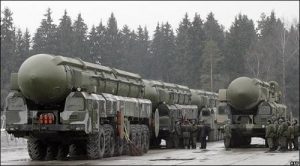By Abhijnan Rej

Update: After the following piece was published, the Pentagon, in a statement about the President and the First Lady’s health and U.S. military readiness, noted: “With regard to reports about E-6B aircraft on alert status, US STRATCOM has confirmed these E-6B aircraft were part of pre-planned missions. Any timing to the president’s announcement was purely coincidental.”
News early on Friday that U.S. President Donald Trump has tested positive for the coronavirus may or may not be the end of the world for his re-election prospects, but minutes before he tweeted out the news himself, two of America’s doomsday planes made themselves visible off its coasts.
Open-source intelligence aficionado Tim Hogan pointed out on Twitter that two E-6B Mercury aircraft were spotted, one at each coast, as the world grappled with the implications of the 74-year old president’s infection with a virus that has killed more than 200,000 Americans so far.
The E-6B Mercuries are operated by the U.S. Navy and serve as a crucial command, control and communications link between the National Command Authority — the president and the secretary of defense and their designated successors and alternatives who can order a military strike, including a nuclear attack – and nuclear missiles onboard SSBNs, but also land-based ICBMs through an airborne launch control system.
Effectively, the aircrafts are a key intermediate link between the chain of command’s decision to launch (or retaliate in kind to) a nuclear attack and the missiles actually taking off subs and siloes. The E-6Bs, derived from Boeing 707 jets with a crew of 22 per aircraft, are equipped with very low frequency (VLF) communications antennas to communicate with SSBNs. They form the airborne component of the Navy’s “Take Charge And Move Out” (TACAMO) communication system.
The fact that not one but two E-6Bs were suddenly spotted around the time the world heard of Trump’s infection serves as strong evidence that this was not a coincidence. As Hogan himself tweeted, the U.S. Strategic Command, custodians of the country’s nuclear weapons and delivery systems, wanted “them to be seen,” as a signal to adversaries that its business as usual when it comes to nuclear deterrence, despite the commander-in-chief’s ill health.
While it is extremely unlikely that U.S. adversaries would launch a nuclear strike simply because the president is coronavirus-positive, one need not be a professional worrier to note that latest development in the White House, coupled with political convulsions in the U.S. and global disarray following the pandemic, can embolden other powers to embark on misadventures. For example, it is not known to what extent China’s push in eastern Ladakh was out of a perceived opportunity as India grappled with the pandemic. The E-6B episode also reminds us of the complex, unexpected links between natural disasters like pandemics and more traditional national-security challenges. (Lawrence Wright’s scarily-prescient new novel about a pandemic that pushes the U.S. and the world to the brink explores them further.)
It also unfailingly reminds us that nukes – and the threat of nuclear war – is still very much alive, the risks having increased manifold over the past few years, between tangled deterrence relationships, failing and frail arms control measures, and rapid modernization of nuclear weapons and associated technologies. Under Trump, the U.S. has sought to firmly put the accent back on nukes in its defense posture and invested in their modernization. It has also taken on its nuclear-armed adversaries head-on, sometimes seeking to put “maximum pressure” on them.
China, for its part, remains committed to building SSBNs that would operate closer to China’s own shores – as opposed to patrolling waters in the vicinity of the United States – increasing their survivability. Russian nuclear modernization involves a marked accent on artificial intelligence as well as hypersonic capabilities, technologies Beijing also remain keen on.
If Trump’s health does not turn around soon, expect more shows of determination from the Pentagon to fend both of them, and others, off.
No comments:
Post a Comment